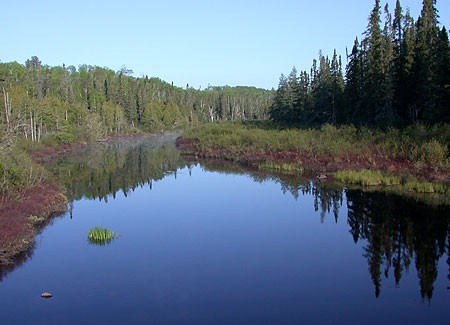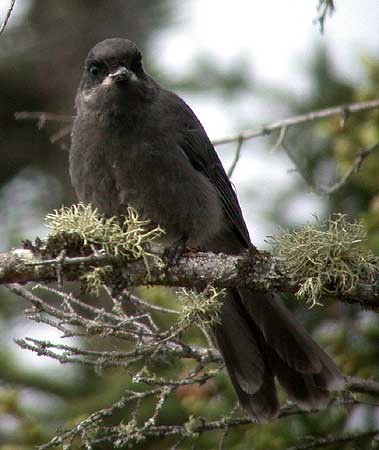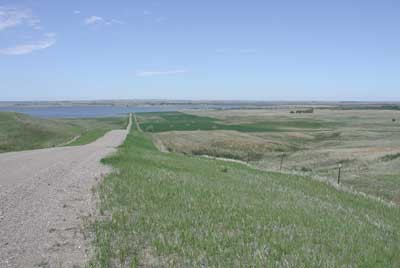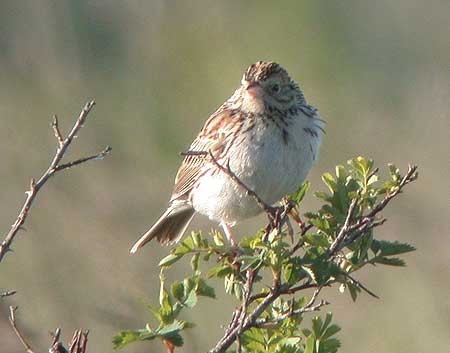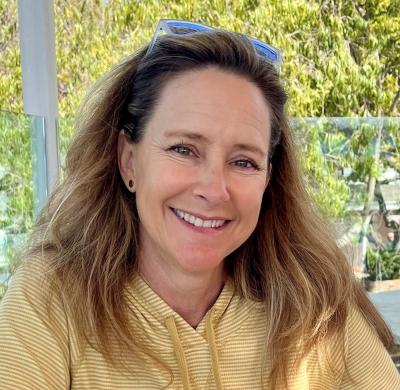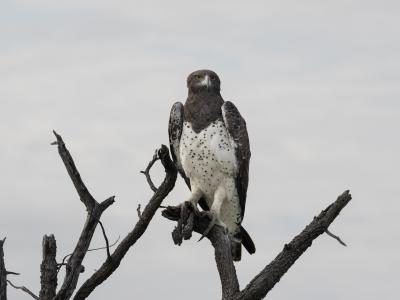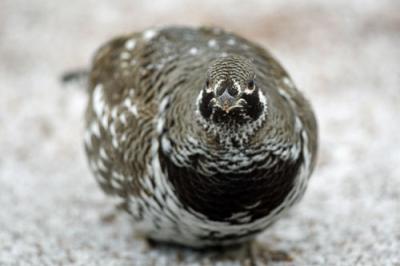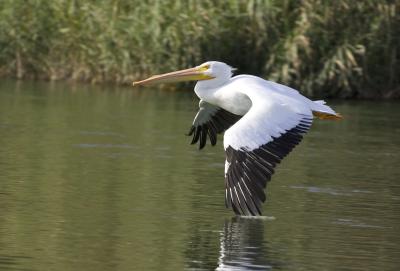Minnesota and North Dakota
North Woods to Prairies
-
May 27 to Jun 4 2025
Ethan Kistler
The wonders of the breeding season in Minnesota and North Dakota could well be the best kept secret in all of birding—and with our small group size, we plan to keep it that way! June landscapes are as lush as the birds are conspicuous. From boreal forests to aspen parkland and the grasslands and prairie potholes of North Dakota, this trip covers some of the richest breeding locales in all of North America.
We’ve recorded over two dozen species of ducks and half a dozen grebes, often with adorable babies. Seventeen species of sparrows are possible, including many of the most difficult species to detect in all of North America. The subtle songs and muted plumages of Baird’s, Henslow’s, Nelson’s, and LeConte’s Sparrows are always among the highlights. But perhaps more than any other group, it is the wondrous warblers that draw us time and again to the region. We typically record at least twenty-five species, and unlike watching warblers during migration, our views are often leisurely and prolonged: imagine scope views of Golden-winged or Mourning Warbler, and Connecticut and Canada Warblers singing from near your feet! We are also on the southern boundary for nesting Great Gray Owls, and we’ll spend an evening or two driving the quiet roads in search of this enigmatic species. On another evening, we’ll visit an extensive sedge meadow to listen for what is certainly a good candidate for the most enigmatic species in the country: the nearly mythical Yellow Rail. With great luck, we may even see one. Perhaps best of all, almost the entire tour takes place far from the hustle and bustle of the city, giving us ample time to enjoy the tranquility of the northern forests and prairie potholes and the tremendous birdlife that calls this region home.
Day 1: The tour begins at 6:00 pm at our hotel near the Minneapolis-St. Paul International airport. Night in Bloomington.
Hard to imagine anything that would improve this tour. Perfect! Evan was without a doubt one of the best tour leaders I’ve been with, possibly the best. Sara was great with details and follow-up. - Jeffrey C.
Day 2: Starting in the Twin Cities allows us a morning to look for birds with more southern affinities—species that are pulled north along the Mississippi and Minnesota Rivers. The winding trails of William O’Brien State Park offer a wonderful opportunity to explore this avifauna that we won’t see later on in the tour including Acadian Flycatcher, Blue-gray Gnatcatcher, Wood Thrush, Blue-winged and Hooded Warblers, Eastern Towhee and Field Sparrow. In recent years Henslow’s Sparrow and Cerulean Warbler have been found in small numbers and we’ll hope to see both of these avian gems. A number of productive regional and county parks and nature centers throughout the greater Twin Cities area will give us additional options for birding before we leave in the afternoon for Duluth. Night in Duluth.
Days 3-4: The northwoods of Minnesota are comprised of a rich variety of habitats from jack pine stands to tamarack bogs, from spruce woodlands and alder swamps to hardwood forests, interspersed here and there with sedge meadows and cattail marshes. From our convenient location in the Twin Ports (Duluth and Superior) we’ll head out looking for such highly prized species as Connecticut Warbler, Yellow-bellied Flycatcher and Great Gray Owl.
We’ll spend one morning along the edges of bogs and coniferous forests, where the woods are alive with warbler songs including Mourning, Canada and Blackburnian. Haunting songs of White-throated Sparrow, Hermit Thrush, Veery and Winter Wren echo from inside the bog, while Blue-headed Vireo and Purple Finch often sing nearby. Just north of Duluth is the southwestern limit of Black-throated Blue Warbler, and we’ll search for it along the little-visited portions of Lake County, where we also have a slim chance of finding Philadelphia Vireos. Also in the forests of Lake County, we have excellent chances for Tennessee, Cape May, and Bay-breasted Warblers, all of which are birds of the true Boreal.
Of course, no visit to the Duluth area would be complete without a trip to the Sax-Zim Bog. This is prime habitat for Connecticut Warbler and we’ll concentrate on finding this species. Other summer residents include Boreal Chickadee, Canada Jay, Olive-sided Flycatcher and Golden-winged Warbler. Displaying Bobolink, Eastern Kingbird, Brewer’s Blackbird and perhaps Upland Sandpiper will give us our first taste of the grassland species that we’ll see in abundance later in the trip. We’ll also make an evening excursion to look for Great Gray Owl and we’ll hope to encounter Moose, Fisher, River Otter, Beaver and if we are truly lucky, a wolf. Nights in Duluth.
Day 5: We’ll keep our morning options open and look for species that we haven’t yet encountered. We may visit nearby Rice Lake National Wildlife Refuge, whose deciduous woodlands and scrubby grasslands hold species such as Black-billed Cuckoo, Eastern Wood-Pewee, Great Crested Flycatcher, Scarlet Tanager, Rose-breasted Grosbeak and Clay-colored Sparrow. In the afternoon we’ll make our way to Grand Forks in time to rest up before an evening in search of the enigmatic Yellow Rail. There are a number of locations for this species in this part of the country and, with some luck and current local information, we can hope to at least hear its distinctive call. Nelson’s Sparrows should also be present in numbers and become more vocal at dusk. Night in Grand Forks.
Day 6: We’ll likely do some local birding around Grand Forks in the morning, perhaps finding some lingering shorebirds at Kellys Slough National Wildlife Refuge, or Red-headed Woodpecker and songbirds along the Red River, before making our way on county roads towards Jamestown. We may pass through Arrowwood National Wildlife Refuge, just to the north of town, where we will hope to find Grasshopper Sparrow, Upland Sandpiper, and perhaps more migrant shorebirds. Late in the afternoon we’ll drive to Jamestown, North Dakota. Night in Jamestown.
Day 7: Today we’ll explore the remarkable freshwater marshes and lush prairies of Kidder County. In the marshes and sloughs the guttural pumping calls of American Bitterns and the cacophony of “song” produced by colonies of Yellow-headed Blackbirds fill the air; Black and Forster’s Terns wheel about over their nests among the cattails, and small flocks of Franklin’s Gulls fly between marshes; Ruddy Ducks, one of more than a dozen species of waterfowl that breed here, engage in their unusual courtship displays while Willets, Marbled Godwits and Wilson’s Phalaropes dart back and forth across the meadows; and American White Pelicans and Eared, Western and a few Clark’s Grebes dot the scattered alkaline lakes. This early in the season there are often still some northbound shorebirds including White-rumped Sandpipers. Piping Plovers are sporadic but possible.
In the prairies Chestnut-collared Longspur and Grasshopper, Vesper and Savannah Sparrows will be common and we’ll listen for the tinkling song of Baird’s Sparrow and the elaborate flight song of Sprague’s Pipit. We’ll also hope to see Dickcissel and Lark Bunting although the numbers of these nomadic birds vary from year to year. These open expanses also attract Northern Harrier and Red-tailed, Swainson’s and Ferruginous Hawks, and each year seems to bring a surprise or two. We’ll have a good chance as well for Sharp-tailed Grouse and we’ll scan roadsides for Gray Partridge. Night in Jamestown.
Day 8: This morning we’ll have the option of revisiting the prairies north of the towns of Tappen and Dawson looking for species we may have missed the day before, or concentrating on more intimate looks at species of particular interest. Or, perhaps we’ll decide to head east to explore the prairies of western Minnesota en-route to the Twin Cities where Greater Prairie-Chicken is possible. After lunch we’ll begin our drive east toward Minneapolis and if time permits, we may do some target birding before reaching our hotel. Night in Bloomington.
Day 9: The tour concludes this morning in Bloomington.
Note: The information presented below has been extracted from our formal General Information for this tour. It covers topics we feel potential registrants may wish to consider before booking space. The complete General Information for this tour will be sent to all tour registrants and of course supplemental information, if needed, is available from the WINGS office.
ENTERING THE UNITED STATES: Non-U.S. citizens will need a valid passport and may need a tourist visa. Consult your nearest U.S. Embassy or consulate for details. Canadian citizens should carry proof of citizenship in the form of a passport or birth certificate.
PACE OF THE TOUR: We will be rising very early each morning in order to be in the field at or before sunrise (around 5:00 am). There will also be several late evenings during the course of the tour to look for rails and/or owls although such forays will always be optional. We’ll make every effort to mitigate the effects of these long days by scheduling time to rest in our motels before supper.
There will be moderate to long drives between destinations on several days.
As a rule breakfasts and lunches will either be taken in restaurants or sandwich shops and in good weather, when appropriate, the leader will purchase supplies which will either be eaten while travelling or in the field. With unforeseen exceptions suppers will be relaxed sit-down affairs in restaurants near the motels.
Most walking will be gentle along well-maintained gravel roads and trails. The exception will be for certain species like Connecticut Warbler and Yellow Rail that may require us to walk in damp to wet meadows and bogs. Please note that we do not make this walk every year as it depends upon water levels. If we do venture into the marsh we will be walking in ankle- to knee-deep water across hummocks which will require being able to lift your feet relatively high and set each down again on potentially unstable substrate, balancing ability and stamina (although the pace will be slow). Expeditions into the marsh are always optional and this is not for everybody. There may be the occasional longer walks, especially on the first day, which may be several hours long.
HEALTH: Birdwatching in Minnesota poses no major health hazards.
Insects: Biting insects can be numerous on several of the mornings and evenings with mosquitoes being the major adversary although we may also encounter blackflies. Those with an allergic reaction to mosquito or blackfly bites may wish to consult their physician. Long sleeves and insect repellents work well to prevent bites. Head nets are generally not recommended as they’re hot and make binocular use very difficult, but you may want to bring one anyway, if you have the space, in case the mosquitos are too bothersome. We can expect to encounter wood ticks in a few locations and deer ticks exist in small numbers in AitkinCounty.
Sun: The days are long, the sun is strong. Wide brim hats and sunscreen are important.
Smoking: Smoking is prohibited in the vehicles or when the group is gathered for meals, checklists, etc. If you are sharing a room with a nonsmoker, please do not smoke in the room. If you smoke in the field, do so well away and downwind from the group. If any location where the group is gathered has a stricter policy than the WINGS policy, that stricter policy will prevail.
CLIMATE: Early mornings may be as cool as 35-40º F (circa 4º C) in some locations with temperatures warming to 65-90º F (18-32° C) during the day. On rare occasions, we have experienced highs only in the 50s F (10-16° C) to as high as 103F. Rain is possible anytime and we can expect it at some point during the tour (though it is usually brief).
ACCOMMODATIONS: We will be staying in comfortable standard hotels throughout the trip, all within close walking distance of a restaurant or restaurants.
Our hotels have good Wi-Fi connections. Cell phone signal is good near our lodging locations but can be intermittent when in the field
FOOD: Food is good American standard. We try to visit a variety of restaurants and cuisines throughout the tour.
Food Allergies / Requirements: We cannot guarantee that all food allergies can be accommodated at every destination. Participants with significant food allergies or special dietary requirements should bring appropriate foods with them for those times when their needs cannot be met. Announced meal times are always approximate depending on how the day unfolds. Participants who need to eat according to a fixed schedule should bring supplemental food. Please contact the WINGS office if you have any questions.
TRANSPORTATION: We will be traveling by leader-driven 15-passenger window van or minivan, depending on the group size. When using 15-passenger window vans, we will take a maximum of seven passengers plus the leader/driver. Participants should be able to ride in any seat in tour vehicles.
Minnesota & North Dakota
2024 Narrative
Our tour began at William O’Brien State Park east of the Twin Cities. Located near the St. Croix River, we spent the whole morning traversing a looping trail through grasslands, marshes, and eastern deciduous forest focusing on birds with southern affinities. Once we head north, a number of these species would be no longer possible to find. We awoke to rainy weather but were happy to see the rain stop right as we arrived. Around the parking lot we were greeted to our first birds – Willow Flycatchers, Brown Thrasher, Field Sparrow, Eastern Towhee, Indigo Bunting, and our first of many species of warblers including superb views of Blue-winged, American Redstart, and Yellow Warbler. In the distance, the calls of Red-shouldered Hawks and a Ring-necked Pheasant added to the dawn chorus while a Wilson’s Snipe ‘winnowed’ above.
As we neared the forest edge, we added Ruby-throated Hummingbird, Yellow-throated Vireo, Blue-gray Gnatcatcher, Baltimore Oriole, Rose-breasted Grosbeak, and a few more warblers with Golden-winged being the most notable, but also Ovenbird and Black-and-white. A wetland area hosted Green Heron, Blue-winged Teal, Wood Duck, Alder Flycatcher and Swamp Sparrow.
Venturing deeper into the forest we continued racking up new species with the likes of Yellow-bellied Sapsucker, Red-eyed Vireo, Veery, Wood Thrush, Mourning Warbler, and Hooded Warbler, one of our main targets here. We ended with no fewer than five individuals seen and heard. We also found a very obliging Acadian Flycatcher, which provided point blank views, before we turned around. By the time we reached the vehicle, the rain commenced, but not before we tallied around 70 species on our morning walk.
After lunch we headed north towards Duluth. A short break at a productive rest area not only provided relief for bladders, but also birds as it’s an eBird hotspot with bird feeders to boot. Here we had our first Red-breasted Nuthatch and Purple Finches, more Yellow-bellied Sapsuckers, and a selection of warblers including Tennessee and a singing Mourning. A couple of adorable Franklin’s Ground Squirrels were our non-bird highlight.
Still with some time before having to check in to our hotel, we visited Park Point to see what migrants were around. On the drive in we spotted a gorgeous male Red-headed Woodpecker. Once at the beach, Common Terns, and Bonaparte’s, Ring-billed, and Herring Gulls were present in good numbers along with a handful of Lesser Scaup and Red-breasted Mergansers. Our first shorebirds consisted of a couple Black-bellied Plovers and a small flock of Dunlin. Before departing we stumbled upon a Merlin searching for migrant passerines just as we were. With few migrants present, we made one last stop before checking into our hotel at the Hartley Nature Center adding Trumpeter Swan, Pied-billed Grebe, Veery, and a colorful selection of warblers including our first Magnolia, Blackburnian, Chestnut-sided, and Canada.
After a good night’s sleep, we rose early and headed towards the renowned Sax-Zim Bog for a day of birding. Well-known for winter birding, as it hosts winter finches, owls, and more, the bog also boasts an incredible array of breeding birds and today we would get our first taste of its spring offerings.
Our first priority of the morning was to drive a loop several times in search of Great Gray Owl. Although rare, this majestic owl breeds in the bog and, if you’re lucky, you may spot them early morning. With chicks this time of year, they are often out later than normal to feed the extra beaks. During our search we had Yellow-bellied Flycatcher, Blue-headed Vireo, Canada Jay, Black-billed Magpie, Golden-crowned Kinglet, Lincoln’s Sparrow, and two more species added to our growing warbler list – Nashville and Yellow-rumped. Sadly, no Great Gray Owls made an appearance and Connecticut Warblers appeared to be considerably late in migration, so none were on territory just yet. An excellent consolation prize was stumbling upon a Gray Wolf along the road before it ran off out of sight.
We spent some time at a nearby damp meadow where Sedge Wrens sang, a couple of Ruffed Grouse were ‘drumming’, and a LeConte’s Sparrow made a brief appearance before receiving a text about a pair of visible Great Gray Owls. We were gladly interrupted and rushed back into the van and raced 10 minutes away where we were rewarded to two absolutely magnificent Great Gray Owls sitting eye level right along the quiet gravel road. We sat there quietly and enjoyed these majestic owls for a prolonged time only leaving after they themselves eventually moved a little further into the spruce trees. This is one of the many reasons this tour is so popular!
After lunch we enjoyed a visit to a private bird feeding station, which was hopping with birds. With close encounters with Purple Finches, Pine Siskins, Rose-breasted Grosbeaks, Ruby-throated Hummingbirds, and Downy and Hairy Woodpeckers side-by-side, we had a great visit. A seemingly out of place Wild Turkey fed below the feeders as an unexpected bonus.
Further south, we turned our focus to the open grasslands and farmlands around the town of Meadowlands. Here we picked up several Bobolinks making their best R2-D2 impressions and a Northern Harrier before finding a Palm Warbler in a nearby bog.
The next morning, we headed north into Lake County and the Superior National Forest. This remote area of northern Minnesota is often void of people and offers a few species that can’t be found at Sax-Zim Bog. We arrived shortly after sunrise at a well-placed bathroom in the forest where we added our first Northern Parula and Black-throated Green Warbler. Shortly after, we found ourselves on an endless gravel road where we were greeted to a harmonious dawn chorus. Here Tennessee Warblers were the dominant species along the road. New additions to our growing trip list included Broad-winged Hawk, Northern Waterthrush, Cape May Warbler, and Winter Wren along with additional views of Magnolia, Blackburnian, and Chestnut-sided Warblers. Working our way towards lunch, we stopped at a wastewater treatment plant, as birders do, and added American Black Duck, Spotted Sandpiper, and a lingering Snow Goose.
After a delectable lunch at a hidden gem of a coffee shop, we made various stops along the Lake Superior shoreline on our way back south towards Duluth. First was Lighthouse Point in Two Harbors which hosted a Common Goldeneye, four Whimbrel, a couple Semipalmated Sandpipers, and our first Clay-colored Sparrow. Further south we continue adding new species including Wilson’s Warbler, Red-throated Loon, and a couple White-winged Scoters.
We tried once more for Connecticut Warbler the following morning with no success. We’d turn our focus on migrant traps with hopes of finding one en-route to their breeding grounds. We did, however, have an incredible morning in the bog picking up two more Great Gray Owls along with superb views of a Black-backed Woodpecker and a cooperative Boreal Chickadee.
Afterwards, we began our long drive west towards North Dakota, enjoying the ever-changing landscape from spruce bogs through an interesting transition zone and eventually to the vast open Great Plains. In western Minnesota we stopped at a rest area that doubled as a birding stop. The bathrooms overlooked a large lake that provided our first Western Grebe and Black Terns. Arriving in Grand Forks, North Dakota we visited a small migrant trap where we had a small selection of migrants including Yellow-bellied and Alder Flycatchers and Pine Siskin along with breeding resident Warbling Vireo.
After dinner, we ventured to a nearby damp grasslands where we started picking up species more typical to these open habitats including Gray Partridge, Northern Shoveler, Northern Pintail, Western Kingbird, Marsh Wren, Grasshopper and Vesper Sparrows, and Western Meadowlark. A LeConte’s Sparrow was the highlight of the evening as it came in nearly to our feet! At dusk we added Common Nighthawk, Sora, singing Nelson’s Sparrow, and a bonus Henslow’s Sparrow singing after dark. This represents the second record in North Dakota since 2021, the first being last year when we had one at the same location.
With many early mornings and late nights, we slept in with breakfast at 6:30 a.m. before heading to Kelley’s Slough National Wildlife Refuge. Along the way we obtained marvelous views of a Nelson’s Sparrow and flushed a couple Sharp-tailed Grouse off the side of the road. The refuge is an important stopover site for waterfowl and shorebirds. Our primary focus was on waterbirds, so we spent a considerable amount of time scanning a couple large bodies of water, which provided our first Gadwall, Redhead, Bufflehead, Forster’s Tern, American White Pelican and Yellow-headed Blackbird. Shorebirds were sadly absent with the high water levels. The surrounding grasslands and prairie potholes were productive with our first Marbled Godwit, Bald Eagle, Franklin’s Gull, and locally uncommon Western Cattle Egret.
Our last-ditch effort to track down a migrant Connecticut Warbler ended in glorious success! We visited a local migrant trap and stumbled upon a Connecticut right upon arrival. It teed up beautifully before disappearing into the thick vegetation. We followed it around for a while, obtaining a couple more quick views and had a bonus Philadelphia Vireo before we headed off for our afternoon drive.
Along the way we stopped at several potholes, each with its own selection of breeders, adding Ruddy Duck, Canvasback, Virginia Rail, Wilson’s Phalarope, Upland Sandpiper, Willet, and a migrant Semipalmated Sandpiper. A brief visit at Arrowwood National Wildlife Refuge to scan of the reservoir yielded a selection of waterfowl and our first Say’s Phoebe and Brewer’s Blackbirds.
We kept getting sidetracked as we continued on our way towards Jamestown due to the excellent birding en-route! We added American Avocet, several American Bitterns, and a nice flock of migrant shorebirds consisting of mostly White-rumped Sandpipers but also Dunlin, Pectoral and Semipalmated Sandpipers, and two Red-necked Phalaropes.
The main objective the next morning was one of the star birds of the Dakotas: Baird’s Sparrow. We headed to an area in Kidder County that had some intact grasslands, sadly rare in modern history. We were greeted to dozens of spectacular Chestnut-collared Longspurs singing from every direction while Marbled Godwits and Willets alerted us from above. We walked loops hoping to catch wind of a Baird’s, finding Sharp-tailed Grouse, dozens of Grasshopper Sparrows, and a bonus pair of Burrowing Owls. The owls seemed to have taken up resident in a burrow, which is excellent news seeing that they are quite rare in this region!
After lunch at a local restaurant, which included a large assortment of homemade pies and other desserts, we checked another patch of intact grasslands. Luck was on our side as we found a vocal individual that provided prolonged views as it teed up and sang right to us.
With Baird’s Sparrow under our belts, we headed over to Horsehead Lake for the remainder of the afternoon. Among the usual mix of waterfowl and shorebirds, we picked out our first Ross’s Goose, rare this time of year, along with Eared Grebes, Ruddy Turnstone, Snowy Egret, White-faced Ibis, and “Krider’s” Red-tailed Hawk.
We spent our final full day slowly working our way towards Minneapolis with plenty of stops in between to break up the drive. After visiting a couple lakes east of Jamestown, we arrived in Fargo where we did the obligatory group photo in front of a particular woodchipper, spotted Gray Partridge on the lawns, and picked up a tasty lunch from my favorite café, before continuing east.
Just before arriving in Minneapolis, we paid a visit to Stanley Eddy Memorial Park, which hosts Cerulean Warblers and the occasional cuckoos. The clouds were ominous with an impending storm, and we only had time for a quick walk before the rains arrived but did record Scarlet Tanager, Ovenbird, Wood Thrush, Eastern Wood-Pewee, and a large number of Red-eyed Vireos and lesser numbers of Yellow-throated. We continued towards the city making one last stop at a dairy farm where a few resident Dickcissels were sitting on the wires in full song, oblivious to the rain. Our final new bird after a very successful tour!
- Ethan Kistler
Ethan was wonderful. Even among bird guides, his song and call recognition is outstanding. He was on top of everything—birds, territories, schedule, unique places to eat. Would love to go with him again.
- Jean T. on Minnesota and North Dakota
Perfect tour! North Dakota was the biggest surprise. I had no idea how green and lush ND was everywhere we went on the tour. Ethan is an excellent and very knowledgeable tour guide. I have been on 16 previous birding tours with other tour companies, so I know a great guide and Ethan is it!
- George R. on Minnesota and North Dakota
This tour is limited to seven participants with one leader.



